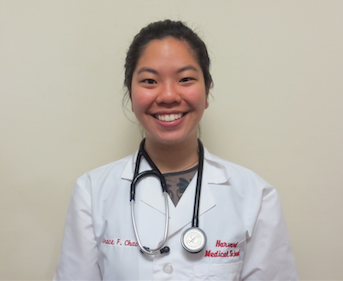By:
Grace Faith Chao
My first patient of the clinical year, John, was a tall, lanky man. He said to me, smiling proudly, “Grace, this is a special year for me.” “Oh yes, I saw that it has been 10 years since your surgery,” I enthusiastically replied. “That’s right! And on top of that, this year I ran my 7th marathon.” Finishing a marathon is no small task. However, it becomes an amazing feat when you consider that 10 years ago, John weighed over 500 pounds. Patient after patient told me about how their surgery had completely changed their lives. They stopped needing their medications; they returned to work; they regained their confidence to build meaningful relationships; they no longer feared dying “before their time.” From the advent of bariatric surgery in the United States in the 1950s to today, bariatric surgery has seen an evolution in techniques, understanding of the impact of our operations, and acceptance of surgical intervention in the fight against obesity. These trends as well as the increased sense of urgency to help our patients who are struggling with obesity will lead to increased acceptance and prevalence of bariatric surgery in the United States.
Improvement in techniques to make surgery safer means that it is more feasible for patients to undergo surgery. In a meta-analysis of 136 studies, operative mortality was just 0.1% for purely restrictive procedures, 0.5% for gastric bypass, and 1.1% for biliopancreatic diversion or duodenal switch (1). For comparison, the mortality from open appendectomy in obese patients with a BMI ≥ 30 was 0.58% and 0.11% for laparoscopic approaches (2). Not only is there a low risk of mortality from the procedure, all the steps of the procedure itself have been made safer; the extensive experience with obesity surgery has led to our ability now to address the special challenges obese patients face (3). These patients are more prone to compression-related injuries, so appropriate padding has become part of standard procedure. Esophageal temperature probes are no longer used since they can migrate into the stomach during stapling. Tools allowing direct visualization of abdominal wall layers has made entry into the peritoneal cavity very safe. Surgeons now retract the posterior fundus downward while bringing the stapler around the tissue at the angle of His to prevent creating a large fundal pouch in the antecolic antegastric Roux-en-Y gastric bypass. There are numerous more examples of how techniques have been refined and continue to evolve to make sure patients have the best outcomes. This makes bariatric surgery a safe and reliable therapy to offer to patients.
We also now have a better understanding of how surgery impacts weight loss. A systematic review and meta-analysis saw a mean percentage of excess weight loss at 61.6% for all patients who underwent either gastric banding, gastric bypass, gastroplasty, biliopancreatic diversion, or duodenal switch, so the weight loss that patients experience is substantial and long-lasting (4). We are also beginning to understand how to identify patients that may benefit from increased perioperative education and counseling and who may require alterations in surgical treatment planning. A recent study found that patients who achieved suboptimal weight loss after bariatric surgery tended to have higher mean BMI, 60 kg/m2 versus the mean BMI of 54 kg/m2 in patients who had successful weight loss. The other significant factors associated with failure to achieve successful weight loss were diabetes and being male (5). Bariatric surgery is thus a reliable tool to help patients when lifestyle changes alone have not been able to achieve the needed degree of weight loss.
Not only do we know bariatric surgery is effective for weight loss, it has also been shown to have benefits for longevity and a host of other health conditions. In 2007, a large-scale study included 7,925 patients who had undergone Roux-en-Y gastric bypass surgery between 1984 and 2002 at a single practice in Utah. When compared to matched subjects, individuals who underwent bypass experienced significantly lower death rates from any cause by 40%. Specifically, death from coronary artery disease decreased by 56%, from diabetes by 92%, and from cancer by 60% (6). There are currently studies underway for patients with Type 2 diabetes with BMI ranging from 30 – 35 kg/m2 to determine benefit from bariatric surgery. So far, the U.S. Food and Drug Administration has already approved the adjustable gastric band in these patients (7). As Dr. Buchwald concluded in “The Evolution of Metabolic/Bariatric Surgery,” we are learning “to unravel the consequences of our operations, what metabolic parameters they influence, and what hormonal and inflammatory processes they alter. With this knowledge, we can eventually learn not only how our current procedures actually work but also how to modify them and plan future procedures based on sound insights and experimental data (8).”
In fact, already this growing knowledge is starting to spawn new ideas for surgical management of obesity. One example is with sleeve gastrectomy which has been shown to have a leak rate higher than duodenal switch (9). This has prompted some surgeons to investigate gastric plication which initiates weight loss with a seemingly similar mechanism as a safer alternative to sleeve gastrectomy (10). Another example is the investigation of techniques involving nerve stimulation. Classically, doctors’ learning of the vagal nerve focused on its efferent effects of acid/pepsinogen secretion, gallbladder function, and exocrine enzyme secretion by the pancreas. However, now understanding that actually 80% of the fibers in the vagal nerve are afferent and go primarily to the hypothalamus and medulla oblongata as well as that many of our current bariatric procedures affect this function of the vagal nerve has led to new techniques in bariatric surgery (11). For example, electronic stimulation or blocking of GI tract targets with implantation of artificial pacers is currently under investigation. The vBloc therapy is the most prominent of these, investigations of which are led by Dr. Scott Shikora, and has the lowest rates of complications of all the current bariatric surgery options, does not require significant diet changes, and has fewer side effects than most other procedures (12). Additionally, 85% of patients with diabetes were able to maintain, decrease, or discontinue their diabetes medications with vBloc therapy (13). The development of these devices may offer surgical intervention in the future that does not involve any change to anatomy, but rather allows for metabolic change via restriction through gastric stimulation.
Health policy and prominent health organization statements are beginning to recognize the importance of bariatric surgery in treating patients with morbid obesity which will decrease bias towards surgical options and allow greater access. Before the Affordable Care Act (ACA), only five states had a state mandate for insurance companies to offer morbid obesity coverage. Since enactment of the ACA, 23 states now have a specific health benefit requirement for insurance to cover obesity surgery. In addition, Georgia, Indiana, and Virginia mandated that at least some policies, but not all, must offer obesity coverage, bringing to the total number to 26 states since 2012 that now require insurance coverage of obesity surgery in some form (14). Such a massive expansion will give many more patients the opportunity to pursue surgical intervention for obesity. Additionally, in our increasingly cost-sensitive environment, bariatric surgery has been shown to reduce healthcare costs for the system as a whole and for patients themselves. Obesity increases healthcare costs for an individual by $1,429 a year, which is 41.5% greater than costs for an individual of normal weight (15). Due to decreases in prescription drug costs, physician visit costs, and hospital costs, open bariatric surgery pays for itself in 4 years while laparoscopic surgery does so in just 2 years (16). Thus, bariatric surgery may be saving patients and the system money in the long-term. The medical community has also had two recent major developments which may lead to increased opportunities for patients to receive bariatric surgery: the classification of obesity as a disease in 2013 by the American Medical Association (AMA) and the 2011 position of the International Diabetes Foundation (IDF) to support bariatric surgery early in the treatment of Type 2 Diabetes. The AMA declared obesity a disease and stated “the suggestion that obesity is not a disease but rather a consequence of a chosen lifestyle exemplified by overeating and/or inactivity is equivalent to suggesting that lung cancer is not a disease because it was brought about by individual choice to smoke cigarettes (17).” This statement may lead to more attention from the government and insurance companies to intervene on this important public health issue. Second, the observation that gastric bypass resulted in full remission of Type 2 Diabetes was made in the 1980s (18), but it was not until very recently that this knowledge has started to affect our routine treatment of this disease. The IDF’s goal with taking this position was to “place the role of bariatric intervention into a public health, clinical, and socioeconomic perspective; it had become a ‘last resort’ rather than an option to consider earlier in the management of T2D (19).” This was an extremely important event in the treatment of diabetes. As Dr. Walter Pories writes, “Over the last three decades, surgeons have achieved what was previously deemed impossible…It is now possible to ‘live without diabetes.’ Even so, skepticism by our colleagues, our patients and the carriers has been so pervasive that less than 1% of the patients who could benefit from metabolic surgery have access. Accordingly, the decision by the International Diabetes Federation…is an important and courageous step (20).” With these important changes in health policy and medical policy, the stage is set for more providers and patients to learn about how bariatric surgery can become a part of their treatment and even cure of obesity and its associated diseases.
There is a growing number of patients who suffer from obesity. In 1990, no states had a prevalence of obesity equal to or greater than 15%; by 2010, no state had a prevalence of obesity less than 20% (21). Currently, more than 1 in 6 youth ages 6-19 is obese which increases to 1 in 3 in adults in the United States (22). We have a moral imperative as physicians to relieve suffering and promote health. The evidence is clear that obesity has long-lasting consequences for the health of our patients. The growing number of people suffering from obesity is a cause for concern and should push us to adequately address the issue through treatments of which bariatric surgery is a key component.
Lastly, an important area of research will be health disparities in the field of bariatric surgery. The current demographics of patients who receive bariatric surgery are incongruent with the populations that suffer the most from morbid obesity. Patients who are African American, from lower income groups, are less educated, and are publicly insured are underrepresented among bariatric surgery patients (23). The majority of the few studies that exist only explore the differences between African Americans and Non-Hispanic Whites (24). There are many patients who would benefit greatly from this procedure who are not getting it. For us to provide equitable care, these issues need to be monitored and the cause of the disparities be found. According to one study, among surgeons themselves, sex and race did not affect the decision to proceed to surgery (25), suggesting that the matter of access to surgery may happen before stepping into the surgeon’s office and perhaps an important role for increased outreach efforts to certain groups or advocacy for more insurance companies to cover these procedures. Research in obesity with a focus on racial diversity may also result in being able to select surgeries that have greater efficacy in different groups. Additionally, with a greater understanding of how different populations experience obesity-related disease, criteria for bariatric surgery may change in the future. In 1991, the National Institute of Health Consensus Development Conference Statement for Gastrointestinal Surgery for Severe Obesity set criteria for bariatric surgery as either BMI of 35 kg/m2 with an obesity-related comorbidity or a BMI of greater than 40 kg/m2 (26). However, Asian Americans begin to suffer from metabolic disorder at a much lower BMI than Non-Hispanic Whites. One study showed that at a BMI of 25 kg/m2, Non-Hispanic White women had a prevalence of metabolic syndrome at 12% compared to a much higher 30% in Asian American women. For men, Non-Hispanic Whites had a prevalence of 22% compared to 43% in Asian Americans. Accordingly, Asian Americans may be one population who benefit from bariatric surgery at lower BMI than that of the current guidelines.
The field of bariatric surgery is an exciting and constantly evolving one. As the problem of obesity in our nation grows, there will be a need for increased efforts by physicians, lawmakers, advocacy organizations, public health officials, researchers, and communities to come together to address the epidemic. With bariatric surgery, we have a powerful tool to alleviate suffering and help individuals have a second chance at a healthy life. As we have seen, there is increasing momentum in our nation that will lead to greater bariatric surgery acceptance and prevalence. I look forward to joining in the care of patients in such a vital and impactful field as a bariatric surgeon.


